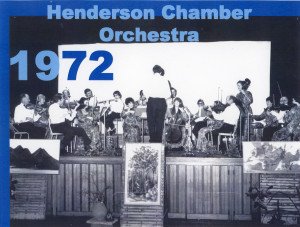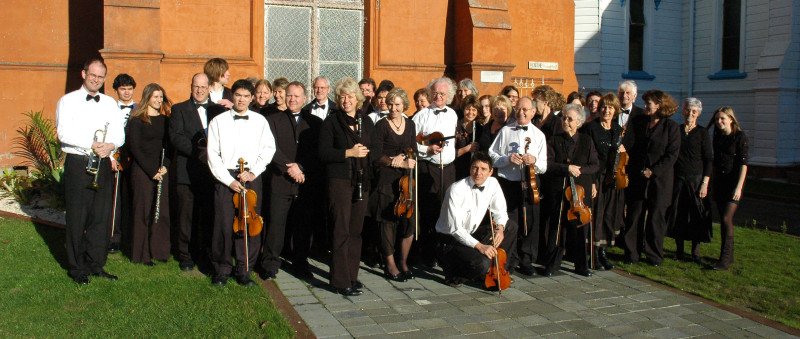Hit enter to search or ESC to close

Celebrating our 50th Anniversary
GOING STRONG 50 YEARS ON

Covid challenges and lockdowns notwithstanding, the PSO celebrated its 50th anniversary in December 2022 – and in the best possible way – a multi-flavoured musical extravaganza at the Mt Albert Memorial Hall concert venue.
The half-century milestone is mainly attributable to the commitment of its two musical directors over the period – first its founder and original director, Joe Isbister (the first 34 years), and then his daughter Joanne Johnston – the current musical director.
“On this anniversary,” says Joanne, “I know my parents would be proud of our progress in fostering music in the community. In accordance with the PSO’s aims we established of the Isbister Fellowship – it’s awarded annually to a promising musician, and it’s also designed to mentor and develop newer players.”
The 50th anniversary, she adds, is a particularly satisfying achievement given the difficult conditions created by the Covid pandemic.
“Our resilience was certainly tested. Although our committee maintained regular meetings online, various lockdowns and traffic light protocols led to uncertainty and disrupted rehearsals and performances. We missed making music together – but we survived.
“Fortunately, we have a solid foundation – over the past decade in particular we’ve had strong leadership in both governance and playing roles. I thank Bruce Baguley for his years of steady guidance as Committee Chair and welcome Jo Farquhar as she takes the helm. Thanks also to our excellent Concertmasters over this time – Robyn Sinclair, Helen Van Druten, Emma Tabachnik and Ruth Allan. They and our section leaders have given willingly of their time and talent to guide and support the players in concert preparation – their dedication is appreciated.”
Genesis

We began life in 1972 as the Henderson Chamber Orchestra
The PSO was founded in West Auckland in 1972 by Joe Isbister to foster the enjoyment of making and performing music.
It began life as the Henderson Chamber Orchestra and mainly comprised Joeʼs family and musical friends – but quickly grew into a thriving community orchestra. Several of Joeʼs grandchildren have played in the orchestra.
Rehearsals and performances were initially held at various West Auckland venues. In 1980 it moved to the Ponsonby Intermediate School Hall (a more central location) and later to the Knox Presbyterian Church (KPC) in Parnell.
KPC was the orchestraʼs ʻhomeʼ for many years, but rehearsals moved to Orakei Primary School in 2012. The PSO currently uses the Epsom Methodist Church Hall for its Tuesday night rehearsals and for storing its music library and percussion instruments.
During the 70s and 80s the orchestra was actively involved in playing for light opera productions with St Thomasʼ Light Opera Club in Glen Eden, the North Shore Operatic Society and the Auckland Music Theatre Company.
In its early years the PSO also had a training orchestra to encourage and develop young musicians’ orchestral playing skills. Many of today’s players are grateful for the group’s nurturing atmosphere all those years ago.
The orchestra performs four concerts per year and plays an eclectic repertoire from orchestral classics to show, 'pops' and film music.
Cool & Stylish
All players in today’s PSO dress in black, but this wasnʼt always the case. The dress code’s evolution over the years has witnessed numerous changes – and much creativity from the members.

Sartorial elegance at its best
In the beginning – when the orchestra played for shows and a more ‘uniform’ look was required – the women and their sewing machines came to the rescue. The first fabric (around 1972) was a bold, purple and pink paisley pattern. Large bolts of it were purchased and the appropriate amount allocated to each female. Luckily, most members could sew.
Three years later the ‘uniform committee’ opted for something more subtle – a black background covered with small sprigs of blue flowers and a collar edged with ric-rac.
In 1978 the women voted for another change – a navy background with a large, blue floral pattern! And with the arrival of younger women it was necessary to create a few ‘floating uniforms’ with flexible middle sections – for loan to pregnant players.
The men, too, received new outfits – light blue shirts and thick velvet black bow ties (to complement the new, blue floral uniforms). As might have been anticipated, most of the men interpreted the appropriate shade of ‘light blue’ fairly loosely – much to consternation of the women.
The last home-made orchestra uniforms were introduced in 1985 – classic navy.

Another variation - the men wore white shirts and bow ties
Soon after the orchestra the shifted to women in black, with the men wearing black trousers paired with white shirts and black bow ties, and then, finally, to the full black outfits worn today.
The 50th Anniversary Concert
To celebrate the orchestra’s legacy, the concert featured a selection of works the orchestra had performed over the past 50 years. These included:
March - The DamBusters Eric Coates (1886-1957)
Eric Coates was a renowned English composer of light orchestral music. In his early career he was a leading violist who combined composition with playing in orchestras. The Dam Busters March was composed in 1954 for the film of the same name. This piece was one of Joe Isbisterʼs favourites – in 1983 it was played in two of our concerts (Glen Eden Playhouse and Knox Church, Parnell).
Symphony No. 8 in B Minor ʻUnfinishedʼ Franz Schubert (1797-1828) Movement 1 Allegro moderato
Despite his short life Schubert produced a large volume of music that spans both the Classical and Romantic Periods. Known for his extraordinary output of songs, he also composed piano music, symphonies and chamber music. He began writing his 8th Symphony at the age of 25, completing only the first two movements. Musicologists still disagree as to why he didnʼt complete the project.
Oblivion Astor Piazzo la (1921-1992), arr. Norberto Vogel
Argentine tango composer Astor Piazzolla created this piece in 1982. It featured in the famous 1984 Italian film Enrico IV (Henry IV) directed by Marco Bellocchio, and is considered one of Piazzollaʼs most popular tangos. Two dancers – John Flower and Natallia Ramanchuk – complemented the music.
Suite for Orchestra Douglas Lilburn (1915-2001)
Often described as “the elder statesman of New Zealand music” (SOUNZ), Douglas Lilburn studied music at Canterbury University and in 1937 joined London’s Royal College of Music to study composition under Ralph Vaughan Williams. Written in 1955, the Suite for Orchestra (five short movements) was composed for the Auckland Junior Symphony Orchestra.
The Waltzing Cat Leroy Anderson (1908-1975)
American composer Leroy Anderson mainly composed short, light concert pieces, many of which were introduced by the Boston Pops Orchestra under the direction of Arthur Fiedler. John Williams described him as one of the great American masters of light orchestral music.
The PSO has performed many of his compositions including Horse and Buggy, Jazz Pizzicato, The Syncopated Clock, Sleigh Ride, The Buglerʼs Holiday, The Typewriter, The Penny Whistle Song and The Waltzing Cat.
Desde El Alma Rosita Melo (1897-1981) arr. Norberto Vogel
Clotilde Mela Rosa Luciano (aka Rosita Melo) was an Argentine-Uruguayan pianist, composer and poet, born to Italian parents. In 1911, at the age of 14, she composed her first and now world-famous Boston-style vals criollo Desde el Alma (From the Soul). The waltz is dedicated to the love of a mother. Dancers John Flower and Natallia Ramanchuk also featured in this performance.
My Fair Lady Selection Frederick Loewe (1901-1988)
Berlin-born Frederick Loewe learned to play piano by ear and in 1925, after attending a local conservatory travelled to New York. He met Alan Jay Lerner during the Depression and together they wrote numerous musicals: Brigadoon, Paint Your Wagon, Camelot and, most famously in 1956, My Fair Lady (based on George Bernard Shawʼs play Pygmalion). It became the pinnacle of the duo’s careers.
Our selection covers the most popular melodies: All I Want is a Room Somewhere, Show me, The Embassy Waltz, Iʼm Getting Married in the Morning, I Have Often Walked, Iʼve Grown Accustomed to her Face, and With a Little Bit oʼ Luck.
Born Free John Barry (1933-2011) transcribed by Phil Hickman
John Barry was the legendary British movie composer of Oscar-winning soundtracks from Out of Africa, Dances with Wolves, and 11 James Bond scores. Born Free was a 1966 British film based on Joy Adamsonʼs 1960 non-fiction book of the same name. It starred a couple who raised Elsa, an orphaned lion cub, to adulthood, and released her into the wilderness of Kenya. Born Free won an Academy Award for Best Original Song.
Phil Hickman (he plays trumpet in our brass section) arranges and/or transcribes popular repertoire for orchestra and string quartet.
Thereʼs Christmas in the Air arr. by Carl Strommen (1939 -)
American Carl Strommen is a leading composer and arranger of instrumental and vocal music and his pedagogical works (in particular) play a major role in the training of young musicians. This orchestral version of the most familiar Christmas season songs includes Iʼll be Home for Christmas, Santa Claus is Coming to Town, Have Yourself a Merry Little Christmas and Frosty the Snowman.
The Pink Panther Henry Mancini (1924-1994) arr. C Custer
Often described as the most successful film composer of his time, American Henry Mancini was the house arranger at Universal Studios and worked on more than 100 films. His song-writing skills often overshadowed his talents as an instrumental composer. The Pink Panther comedy films, dating from 1964, features a bumbling French police detective and is most closely associated with actor Peter Sellers. Mancini composed the music for the first movie.